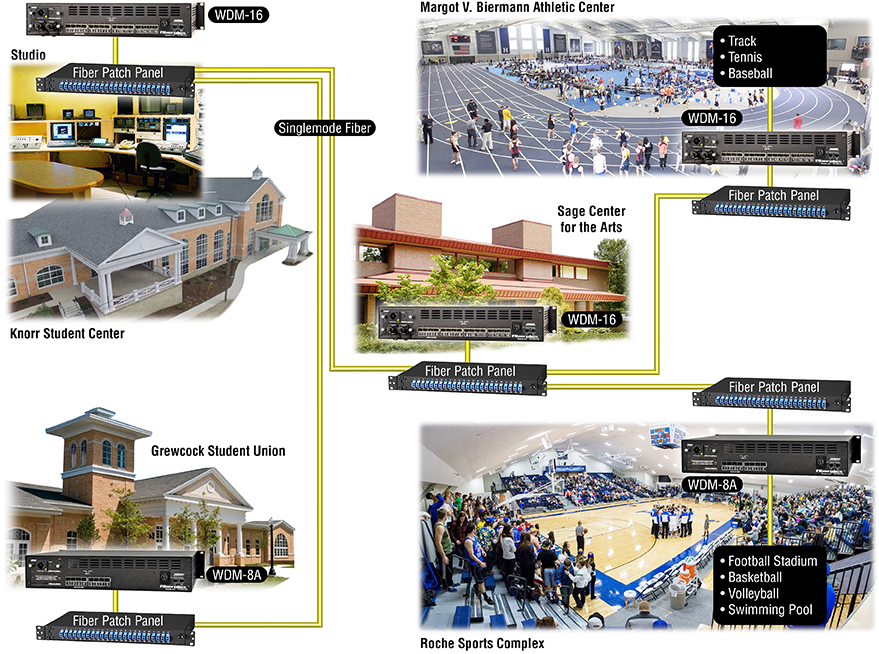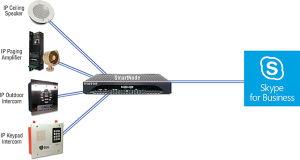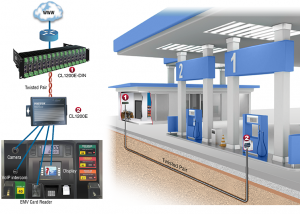The Powerful Benefits of Designing an Infrastructure First
Artificial intelligence, virtual reality, IoT, AVoIP, 8K, 5G… All of these expanding technologies cannot and will not function without a quality communications infrastructure in place.

Shopping for the latest and greatest video wall or digitally steerable network controlled line arrays, or any other ‘cool’ endpoint solutions can be a tempting way to begin a system design, however; developing a reliable, interoperable, upgradeable and secure infrastructure upon which all of this technology can flourish is the correct first step to a successful project.
The Problem… Infrastructure as an afterthought
Fortunately, there are many innovative solutions for overcoming the countless problems that arise as the result of systems that are designed with the infrastructure as an afterthought:
Here is an example of a college campus that installed just enough fiber for their IT department to utilize, leaving no Infrastructure available for the AV broadcast team.

Patton Electronics’ Fiberplex WDM16-L active wave division multiplexers enabled the college to expand their limited (6) strands of fiber that were installed to (96) strands of fiber by simply installing a 2U rack-mounted device on either end of each pair of fiber. This eliminated the costly process of trenching and directional boring in order to install new fiber.
This is one of a myriad of examples wherein there is a solution designed to overcome the problem, and at the same time, this problem can be eliminated by educating consultants, integrators and end-users of the powerful benefits of always starting a new project by understanding and developing the Infrastructure First. Get to know the architects, at the initiation of a new project, and become one with the environment you will be enhancing.
The Solution… Build the communications infrastructure first.
Fiber optic cable is by far the most “future proof” transport medium available. Currently, engineers are testing the transport of petabits (1000 Terabits) worth of data on single-mode fiber, equating to an upgrade path for just about anything the AV market can throw at it. Fiber is the most secure way to transport data. Distance limitations are virtually non-existent. The advantages of fiber are countless, so install as much as you can wherever you can.
At the same time, there are many scenarios where existing copper cabling from legacy systems can/should be reused, eliminating the need for demolition and reinstallation while at the same time recycling and minimizing waste. If the Communications Infrastructure is considered at first place, everyone, including the environmentally conscious can strongly benefit:
Here is an example of when the US switched from swipe credit cards to EMV “chip cards” POS terminals needed to be upgraded, but the twisted pair cable in the ground would not support Ethernet connectivity to those new terminals.
Wiring upgrades at a gas station can be an expensive and disruptive construction project involving getting permits scheduling inspections and shutting down operation. Instead, the addition of Patton’s CopperLink Ethernet Extenders enables network connectivity over the preexisting copper infrastructure.
Communications Infrastructure… Not just cables, patch panels and wall plates.
Twisted pair copper cabling, Cat-X, multimode and singlemode fiber, all function as transport mediums for communications systems of every type. Even wireless communication, Satcom and radio require a physical infrastructure at some point in the signal path, and it is of utmost importance that the individual/s designing and installing any type of communications system recognize that the communications infrastructure is the foundation upon which all else can be built. Regardless of the transport medium/s in place, leveraging Patton’s technology solutions to develop and build a complete Communications Infrastructure, enables solutions providers and end users alike with the ability to: a.)

Interface with the legacy technologies of yesterday that still hold value today (example. Analog telephones in a Microsoft Skype environment); b.) Enjoy a modular upgrade path to the technology of today and tomorrow (example. Modernizing to all IP), and; c.) Build a foundation that is as close to “future proof,” as conceivable (example. Supporting the upgrade from 1080P to 4K to 8K and beyond).
In conclusion, here are four simple questions to get you focused on infrastructure first on your next project:
What is the current infrastructure in my project?
This is where it all starts. Having a thorough understanding of the existing cable plant can drastically reduce costs and expedite completion.
Are there infrastructure elements in place that can be reused?
There are many solutions on the market that allow the reuse of existing wiring. Many buildings are full of unused twisted pair, coax, and old CAT-X cabling (telephone, alarms, etc.…), which can all be repurposed for modern communications, saving time, money and the environment.
The same holds true for fiber. If there is fiber in place that was abandoned or not filled to capacity, there are many solutions to transform and maximize this infrastructure to meet the project needs.
How much of the project needs new infrastructure?
Once you determine how much of the old infrastructure can be used, you will have an idea of what will need to be added. Think this through carefully. Think about the future. You can add significant value to your bid or project by building infrastructure overhead into the project. The cost is minimal and the benefit huge when you pull more fiber than what is needed for the immediate requirement.
Are there existing/legacy systems that are out of project scope but still need to be supported on the new infrastructure?
Think of a school or campus with an existing PBX telephone system, paging system, and mass notification system. Often times modernizing these systems by IP enabling them makes much more sense than replacing them. Incorporate these systems into the infrastructure scope and effectively increase your opportunity for additional projects.
The rate at which new technology is exponentially advancing is staggering. A well thought out ‘Infrastructure First’ design approach provides the reliable, interoperable and upgradeable foundation upon which all future communications technologies can be built. We call this… Intelligent Connectivity!
Source: Patton - Kyle Rosenbloom









